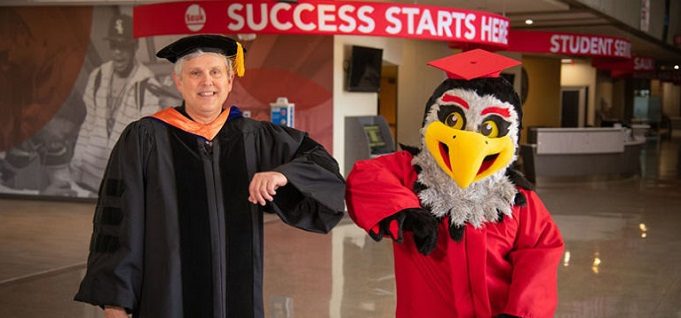Building a solid foundation
By Ed Finkel
April 13, 2022
When Sauk Valley Community College was founded in 1965, the Sauk Valley College Foundation was simultaneously established alongside it as an independent 501(c)(3). The college’s founders had the foresight to know that philanthropy would be critical to building a college-going culture in the rural northwestern Illinois community it served.
By the time David Hellmich became president of Sauk Valley a half-century later, the one-third of operational funding once provided by the state had been cut by more than half, which made finding non-tax-dollar funding sources all the more important.
“We were doing budget projections at that time, showing us having no reserves four or five years down the road,” Hellmich said. “In fiscal year 2016, we essentially got no funding from the state,” due to a budgetary showdown between the governor and statehouse leader. “In fiscal year 2017, we ended up getting most of our funding [once the standoff was resolved], but we didn’t know about that until essentially after the fact. We realized how tenuous it was, so we knew that we needed to start being a bit more entrepreneurial.”
The foundation seemed like a good place to start, although Hellmich noted it had never so much as carried out a capital campaign in the past.
“I’d call it sort of a ‘pancake breakfast’ foundation” at that time, he said. “Frankly, the college had not invested all that much in the foundation. We only had a manager and an administrative assistant.”
Hellmich took a senior foundation board member to lunch and asked for advice, and he was told: “You can’t expect people to invest in the foundation if the college does not invest,” which prompted Sauk Valley to expand the foundation’s staff to six and hire Lori Cortez as dean of institutional advancement. In exploring how to expand the foundation’s funding and influence, Cortez researched the potential of Promise programs, putting together a whitepaper that explored the benefits — and won over the foundation’s board.
“It was not a matter of me going to a meeting and saying, ‘Foundation, you’re going to do a Promise program,’” Hellmich said. “It would have been dead in the water if that had been the case.”
Multiple benefits
On May 1, during the American Association of Community Colleges’ 2022 Annual conference, Hellmich and Cortez will present Sauk Valley’s story as a case study of how creating Promise programs on rural campuses can help not only attract and retain students, but also develop the local workforce, attract and retain businesses, and in general bolster economic development of the surrounding community.
“This is so much more than a scholarship program,” Cortez said. “This program has been shown to retain population, retain businesses and bring in a new population and new businesses. When we look at the other 300 Promise programs in the nation, they have the economic development that stands behind those data. So we were able to really convince people that this is a good idea.”
Area employers testified that they had more than 20,000 well-paying jobs available that they couldn’t fill because they couldn’t find qualified applicants. “Well, we here at the college, we have the training, right?” Cortez said. “We have the credentials that we can bestow upon a student who earns it.”
Volunteer component
Like most Promise programs, Sauk Valley’s “Impact Program” is a last-dollar program, meaning it is applied after all other student aid for which a student qualifies. And like a number of Promise programs, it has a volunteering requirement, which has created a great deal of buzz, Hellmich said.
“You have the nonprofits who need volunteers,” he said. “You have places of worship. There is so much buzz going on … because of the labor people get, and even more so, that connection that Lori talked about. Kids are going to learn about what’s going on in their community and be more invested in their community.”
In the two communities where Sauk Valley piloted the Impact Program last summer, 86 students signed up and put in more than 900 volunteer hours in the aggregate, Cortez said.
“We are rolling it out throughout the entire six counties now,” she said, meeting with eighth-graders and their parents to gin up fall signups. “This is not something we plan to do. This is something that we have, in fact, begun.”
Since the concept got rolling in 2016, the college foundation’s coffers have swelled from $3.1 million to $11.5 million — not including a $5 million estate gift committed to the college, Hellmich said.
“By the college committing resources, and by the college and foundation collectively developing a compelling argument and a compelling case for the Impact Program, and having a capital campaign, it has done wonders for our fund-raising ability,” he said.
There’s more to the story! Read the full article in CC Daily.



